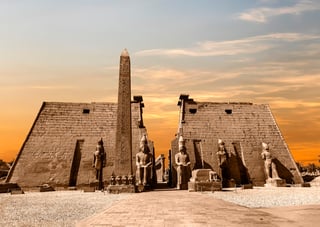Luxor, also known as Al-Uqṣur or El-Aksur, is a city in Upper Egypt that has a rich history and is famous for its temples and tombs.
It was once the capital of the ancient Egyptian city of Thebes and is known for its remarkable archaeological sites. This article explores the key temples and monuments in Luxor, providing insights into their historical significance and architectural marvels.

Luxor: A Brief Overview
- Location: Luxor is situated in the Al-Uqṣur muḥāfaẓah (governorate), covering an area of 1,080 square miles (2,800 square km). The city itself spans 160 square miles (415 square km).
- Population: As of 2017, the governorate had a population of approximately 1,250,209, while the city had an estimated population of 127,994 in 2018.
The Ancient Ruins
Luxor Temple Complex
- The southern part of Thebes developed around the Luxor Temple complex, dedicated to Amon, king of the gods, Mut, and Khons.
- Commissioned by King Amenhotep III during the late 18th dynasty (reigned 1390–53 BCE), the temple featured an avenue of sphinxes connecting it to the Great Temple of Amon at Karnak.
- The modern name "Luxor" is derived from the Arabic "Al-Uqṣur," meaning "The Palaces" or possibly "The Forts."
Temple of Luxor
- The original part of the Temple of Luxor included a large peristyle court and a complex of halls and chambers.
- Notable features include a granite shrine of Alexander the Great and a great peristyle forecourt surrounded by papyrus-cluster columns.
- Ramses II made significant additions, such as an outer court with colossal statues of himself, a lofty pylon, and obelisks.
- The temple has a rich history, including periods when it was converted into a Christian church.
- Luxor, along with other Theban sites like Karnak and the Valley of the Kings, was designated a UNESCO World Heritage site in 1979.
Later History
- Luxor's history includes Roman influence, with a legion headquarters inside the 18th-dynasty temple.
- In the Fāṭimid period (909–1171), a mosque was built over a church in the temple's court, dedicated to Sheikh Yūsuf al-Ḥaggāg.
- Luxor's annual festival of Opet, featuring a boat procession and reliefs depicting sacred barks, has ancient roots.
- Ongoing excavations and preservation efforts have revealed more about Luxor's past.
Contemporary Luxor
- The modern city of Luxor has expanded north, south, and east of the temple.
- It hosts churches and mosques, reflecting the religious diversity of its population.
- Luxor boasts a railway station, airport, and ferry service, facilitating tourism and transportation.
- The Luxor Museum, opened in 1975, showcases archaeological treasures.
- The city offers numerous tourist facilities to accommodate visitors.
Luxor's Remarkable Temples and Sights
Luxor is often referred to as the "world's greatest open-air museum" due to its plethora of historic temples and monuments. Here are some notable sites:
On the East Bank of the Nile
Luxor Temple
- Founded in 1400 BCE during the New Kingdom, Luxor Temple employs symbolism and illusionism in its design.
- Dedicated to the Theban Triad of Amun, Mut, and Chons, it was a focal point of the annual Opet Festival.
- The temple was built and modified over various eras, including the Roman period and Alexander the Great's time.
Karnak Temple
- Karnak Temple Complex is a vast collection of temples, chapels, pylons, and buildings spanning multiple dynasties.
- It is considered the largest ancient religious site globally and features the awe-inspiring Hypostyle Hall with 134 massive columns.
On the West Bank of the Nile
Deir el-Bahari
- Deir el-Bahari comprises three temples, with Hatshepsut's Mortuary Temple being the most prominent.
- Hatshepsut, a female pharaoh, ruled dressed and acted like a man and left behind a unique terraced temple with a three-level colonnaded structure.
Conclusion
Luxor's temples and tombs offer a fascinating glimpse into ancient Egyptian history, architecture, and culture. The city's rich heritage, combined with its modern amenities and accessibility, make it a must-visit destination for history enthusiasts and travelers from around the world.


To help us improve